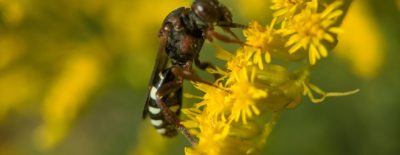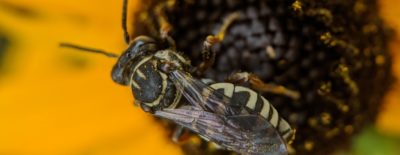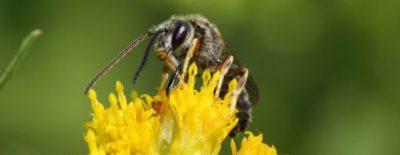From late July through early September, goldenrods are one of the most obvious flora resources in the VT landscape. Not surprisingly, many bees have evolved to take advantage of the abundant pollen and nectar. Many of the specialists are relatively distinctive, making this a great plant to focus on for bee photography.

Mining Bees (Genus Andrena)
At least 8 Mining Bee species have been found on Goldenrod in Vermont. Several are widespread and common, while others are only known from 1 or 2 records. Most are identifiable from clear photos. Image courtesy Micheal Veit.

Goldenrod Cellophane Bee (Colletes solidaginis)
This gorgeous bee has been found on goldenrod in a few sandy places. At least females are easily recognizable. Image courtesy Micheal Veit.

Spine-shouldered Cellophane Bee (Colletes simulans)
This is the most common fall Cellophane Bee in VT. Females can be readily recognized, though a few other uncommon Cellophane bees are possible on goldenrod, most appear intermediate between this and the Goldenrod Cellophane. Image courtesy Micheal Veit.

Nomad Cuckoo Bees (Genus Nomada)
Most fall Nomad Bees are parasites of Mining Bees. Unlike their spring counterparts, the fall species are generally identifiable from photos, and in many cases their hosts are known. Most are uncommon to rare.

Genus Pseudopanurgus
These small, black bees are almost always found on goldenrod (and related plants). Two species are currently known from the state, but the taxonomy of this genus is likely to change soon.

Eight-spotted Miner Bee (Perdita octomaculata)
A very odd, small bee that is easy to overlook, but relatively common on goldenrods (and related plants), especially near sandy areas.

Notch-backed Cellophane-cuckoo Bee (Epeolus scutellaris)
This is thought to be a cleptoparasite of Spine-shouldered Cellophane Bees, and the two species often co-occur. There are other, rare Epeolus species that could be on goldenrod, but this one can usually be recognized by the red on the thorax.

Long-horned Bees (Genus Melissodes)
Several Long-horned Bee species are thought to have strong preferences for goldenrods. Drury's Long-horned Bee is a relatively common species that is somewhat distinctive. The rest of the fall Long-horned Bees are challenging to ID from photos.

Goldenrod Longhorn-Cuckoo Bee (Triepeolus pectoralis)
Thought to be a cleptoparasite of Drury's Long-horned Bee, the Goldenrod Longhorn-Cuckoo Bee can be found on a variety of flowers, including goldenrod. This species can only be reliably identified with a close, sharp image.

Masked Bees (Genus Hylaeus)
Various masked bees are active for the majority of the summer with a few species persisting into the fall and frequently found on goldenrod. Some, but not all are identifiable from photos.

Blood Bees (Genus Sphecodes)
Cleptoparasites primarily of Lasioglossum, several species of these black and red bees are active in the fall and often found on goldenrod. Species level-id is impossible for the vast majority of individuals.

Furrow Bees (Genus Halictus)
This ubiquitous genera of generalist can be common on goldenrod.
Goldenrod Distribution: To see the global distribution, check out the iNaturalist account, and toggle the GBIF layer on the map.






